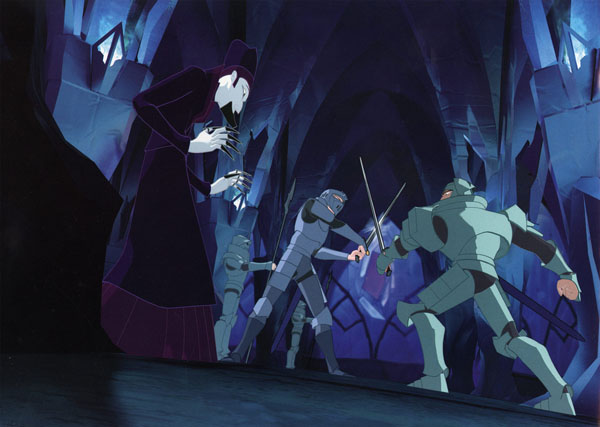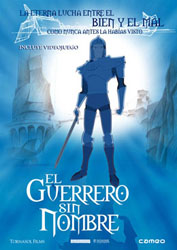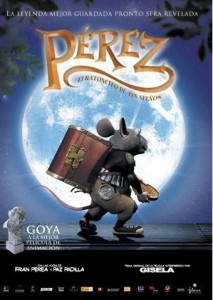
El Guerrero sin Nombre (aka The Nameless Warrior; The Mercenary)
Part seven of my survey of Argentine animated feature films – today with films from David Iglesias and Juan Pablo Buscarini – and another visit with Patoruzito.
 El Guerrero sin Nombre (The Nameless Warrior; The Mercenary), directed by David Iglesias. 81 minutes. April 7, 2006.
El Guerrero sin Nombre (The Nameless Warrior; The Mercenary), directed by David Iglesias. 81 minutes. April 7, 2006.
In a fantasy Dark Ages when knights in armor rode flying reptiles, this depressing, bleak world was ruled by the cruel Grand Master Ágraton. One knight, a nameless mercenary, is weary of his life but feels helpless to change it. When he is ordered by Ágraton to guard a party of smugglers venturing into the Great Desert, he does not realize what he will find. (It includes clues that This Is Not Our Earth, as if the flying reptiles weren’t enough).
Another Argentine-Spanish co-production, between the Patagonik Film Group and Spain’s Tornasol Films, in surprisingly crude CGI. This is one that may be more Spanish than Argentine, since Patagonik had already shown that it could produce much better CGI than this. Despite Patagonik’s claim that it was the major producer, only Tornasol is credited on the film and it was never released in Argentina — only in Spain, France, and Hungary.
Patoruzito: La Gran Aventura, directed by José Luis Massa. 81 minutes. June 26, 2006.
Given the great success of Patoruzito in 2004, a Patoruzito 2 from the Patagonik Film Group was no surprise.
Patoruzito is living happily on his estancia, riding Pamperito. They rescue a mailman who has fallen into a river. He has a letter inviting Patoruzito and his household (nanny La Chacha, foreman Ñancul, younger brother Upita, and colt Pamperito) to Buenos Aires to lead a group representing the Tehuelches in a big national parade. Patoruzito has never been to the big city before and he asks the advice of Malén and old Egolia. They urge him to go.
 In Buenos Aires they meet Col. Cañones and Isidorito again. Among the other Tehuelches in the parade are the brujo Chupamiel and his grandson Chiquiziel. The national parade is watched by all Porteños (inhabitants of Buenos Aires), broadcast by TV announcer Dolores Fuertes. Jiuma the evil witch tries to ruin it with her two nasty young acolytes, Fritz and Coco. Patoruzito foils their sabotage and is honored on TV. This earns him the enmity of Jiuma, but she also plots to make him unwittingly help her.
In Buenos Aires they meet Col. Cañones and Isidorito again. Among the other Tehuelches in the parade are the brujo Chupamiel and his grandson Chiquiziel. The national parade is watched by all Porteños (inhabitants of Buenos Aires), broadcast by TV announcer Dolores Fuertes. Jiuma the evil witch tries to ruin it with her two nasty young acolytes, Fritz and Coco. Patoruzito foils their sabotage and is honored on TV. This earns him the enmity of Jiuma, but she also plots to make him unwittingly help her.
Buenos Aires is a city of many parks and fountains. Most of the fountains have coins in them. According to popular legend, people who tossed a coin into a fountain and made a wish would have that wish granted. The reason it doesn’t work any more is that the Porteños became too materialistic and didn’t believe in magic any more, and all the fairies who lived in the fountains and granted wishes left for fairyland. Patoruzito 2’s plot is that there is still one fairy, Limay, living in Buenos Aires, but her fountain is in the grounds of an old mansion that has become a haunted house protected by its ghost, Benito, and Jiuma can’t get at it. She poses as a fortune teller, and asks Patoruzito and his friends to break the curse on the mansion.
Patoruzito, Isidorito, and the others have typical haunted-house adventures, including meeting Benito. Patoruzito begins to suspect that Jiuma has an ulterior motive, but before he can act, Isidorito leads Jiuma to Limay’s fountain. The witch reveals herself, captures Limay, and flees on her broomstick. Patoruzito’s pursuit of Jiuma throughout Buenos Aires is unsuccessful, but he does meet friendly police officer Vieytes as a result.
Jiuma puts Limay into a chest filled with water and throws coins in it, forcing Limay to grant her wishes. She wishes to become a glamorous woman and the most powerful of all witches. Jiuma fills the city with rats, snakeline vines, bats and an army of cockroaches turned into ogre goons, and brings in other witches and wizards to serve her. Buenos Aires is thrown into panic. Jiuma plans to have herself crowned Queen of the Witches at Buenos Aires’ prestigious Teatro Colón opera house. Patoruzito opposes her with the help of Isidorito, Benito the ghost, Chupamiel and Chiquiziel. They capture Fritz and Coco and dress Patoruzito and Isidorito in their robes to enter the Teatro Colón in disguise. There is a climactic battle between Patoruzito and a CGI dragon. Limay is freed and takes back her magic from Jiuma, who becomes weak and helpless with her ogres, bats, and flying monsters turned back into cockroaches and harmless birds. The parade is resumed, and Malén comes from Patagonia to join Patoruzito.
An artistic flaw was that Quinterno’s characters were drawn in Quinterno’s rounded, bulbous-nosed art style, and everyone else was drawn in a leaner, sharper-nosed art style. They didn’t match well.
El Ratón Pérez (Pérez, the Rat; The Hairy Tooth Fairy), directed by Juan Pablo Buscarini. 90 minutes. July 13, 2006.
In English-speaking countries, the human Tooth Fairy exchanges a child’s loose tooth for a coin. In Spanish-speaking countries, it’s Pérez the mouse or rat who does the same thing. El Ratón Pérez was created as a children’s fantasy by Spanish author Luis Coloma in 1894, commissioned by Queen Mother Maria Cristina as a bedtime fairy tale for 8-year-old King Alfonso XIII who had just lost a tooth. There have been Spanish-language children’s books, plays, dolls, and toys about Pérez the rat throughout the 20th century. The Spanish and Latin Americans seem to call Pérez a ratón or a ratoncito (rat or mouse) interchangeably.
 The movie is a combination of live-action and CGI. Parents Santiago (an unemployed chef) and Pilar (an architect) are cooking dinner while young daughter Lucía is roller-skating through the house. She runs into an ironing board and loses a tooth. A rat overhears Pilar promising that Pérez the rat, “the hairy tooth fairy”, will exchange a gold coin for Lucía’s tooth while she is asleep that night. The rat radios a message to Pérez’s ship in Buenos Aires harbor (captained by rat Commandante Permanencio Fugaz), where Pérez (with his secretary María Laucha) runs a large assembly line of hundreds of rats polishing lost teeth and machining them into pearls, that they exchange for gold coins (actually the current British gold-colored £1 coins) with an old friend, the elderly human jeweler Justo Morientes.
The movie is a combination of live-action and CGI. Parents Santiago (an unemployed chef) and Pilar (an architect) are cooking dinner while young daughter Lucía is roller-skating through the house. She runs into an ironing board and loses a tooth. A rat overhears Pilar promising that Pérez the rat, “the hairy tooth fairy”, will exchange a gold coin for Lucía’s tooth while she is asleep that night. The rat radios a message to Pérez’s ship in Buenos Aires harbor (captained by rat Commandante Permanencio Fugaz), where Pérez (with his secretary María Laucha) runs a large assembly line of hundreds of rats polishing lost teeth and machining them into pearls, that they exchange for gold coins (actually the current British gold-colored £1 coins) with an old friend, the elderly human jeweler Justo Morientes.
Unknown to Pérez, Fugaz and Morientes’ helper/nephew Pipo are conspiring to take everything over. Fugaz wants all the pearls, while Pipo, an unscrupulous amateur chemist, wants Morientes’ jewelry and the hundreds of Pérez’s rat workmen, whom he will drug and sell as mindless “Ratoncitos”, “automatic rat toys without batteries”. (Fugaz intends to replace them with an automated tooth-to-pearl machine.) They strike just before Pérez can exchange Lucía’s tooth for a gold coin. When Lucía does not have a coin the next morning, she tells her parents that something bad must have happened to the Hairy Tooth Fairy; but they ignore her because Santiago has just taken a desperation job as chef at Laurel (Gordo/Fatso) and Samanta’s La Fritada greasy spoon diner on the waterfront (conveniently right across the harbor from where Pérez’s ship is moored). Lucía disobeys her parents to look for Perez herself, with the help of her brainy cousin Ramiro, a juvenile inventor.
Lucía & Ramiro liberate Pérez who is hidden in Morientes’ jewelry shop, but they are immediately separated. Lucía & Ramiro, trying to reach Pérez’s ship, meet Pipo. They try to outsmart each other. Ramiro’s “balsicleta” (flying/floating bicycle) permits the children to board the ship, despite Pipo’s sabotage of it. Meanwhile, Pérez goes to a rat dance palace inside a jukebox in the basement of La Fritada, run by d.j. El Rata, to ask his help. El Rata considers humans to be the rats’ enemies and isn’t interested, but he respects Pérez’s integrity and finally agrees. Meanwhile again, Santiago discovers the rats’ dance palace in La Fritada’s basement, which leads him and Pilar to follow Lucía and Ramiro (with Gordo’s & Samanta’s help) to Pérez’s ship. In the finale Pérez frees the rat workers, Lucía & Ramiro are captured by Pipo but escape with Morientes, Fugaz is defeated by Pérez and María, Pipo becomes a victim of his own formula, the children are rescued by their parents, and Santiago, Pilar, Gordo, & Samanta turn La Fritada into La Fritage, Santiago’s dream gourmet restaurant, with an improved rat dance palace on the roof.
El Ratón Pérez was a major success, publicly and critically. It won both Spain’s Premio Goya (for Spanish-language) and Argentina’s Premio Cóndor de Plata (for Argentine-produced) in 2007 for 2006’s Best Animated Feature category. The feature had a subtitle, “el ratoncito [sic.] de tes sueños” (the mouse of your dreams), that did not appear on the film but was added to the theatrical posters; and did appear on El Ratón Pérez 2.
Next week: Argentine Animated Features, Part 8: 2007-2008


 Fred Patten (1940-2018) was an internationally respected comics and animation historian. He has written about anime or comic books for publications ranging from Animation Magazine and Alter Ego to Starlog. He was a contributor to The Animated Movie Guide (2005), and is author of Watching Anime, Reading Manga (2004, Stone Bridge Press), a collection of his best essays, and Funny Animals and More (2014, Theme Park Press), based upon his early columns here on Cartoon Research. He passed away on November 12th, 2018.
Fred Patten (1940-2018) was an internationally respected comics and animation historian. He has written about anime or comic books for publications ranging from Animation Magazine and Alter Ego to Starlog. He was a contributor to The Animated Movie Guide (2005), and is author of Watching Anime, Reading Manga (2004, Stone Bridge Press), a collection of his best essays, and Funny Animals and More (2014, Theme Park Press), based upon his early columns here on Cartoon Research. He passed away on November 12th, 2018.





































I dare say that ” El guerrero sin nombre ” is not an animated argentinian film. Maybe Patagonik produced the film in economic terms, but I believe that no Argentine artist works in that movie. Nobody in argentinian animation world knows about this film.
Pérez was never considered a rat (rata), he’s only known as a mouse (ratón), while “ratoncito” just means “little mouse”.